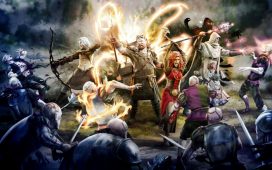Editor’s note: Shenmue’s a game that can do funny things to people. First time round I was obsessed with AM2’s detail-rich world, and its take on a place that seemed oh-so-real – Japan in the mid-80s, specifically life in the unremarkable town of Yokosuka. So obsessed was I that when I first made it over to Japan some years later, the first thing I did was drag my partner to the location that inspired it all – a short hour’s ride from Tokyo itself – and was impressed how Shenmue had captured the place.
The sequel went to Hong Kong, while the third game finds itself in rural China, out in Guilin. How faithful exactly is Shenmue 3’s take on that world? British-Chinese journalist Lu-Hai Liang was born there at the very time the game takes place, so I was fascinated to get his take on how well Shenmue had captured his birthplace.
I didn’t expect to like Shenmue 3. I’d been warned that the game is slow and creaky, and from images I’d glimpsed, the visuals looked like the graphical equivalent of North Korean fashion – simple and outdated. I never played the original Shenmue or its sequel, which came out in 1999 and 2001 in Japan, respectively, on the Sega Dreamcast. Back then I was watching my friend play through the four discs of Final Fantasy 8 on my PlayStation, dreaming of playing football for England, and wondering when the PlayStation 2 was going to come out, with its mythical Emotion Engine. Over the years, I’d heard of the awe and fondness this series evoked in the people who’d played it: the sense of atmospheric reality that Yu Suzuki, the creator of Shenmue, had conjured.
But I am entirely free of nostalgia – having no memories whatsoever of the first two titles – and here I was in late 2019 loading Shenmue 3 on my PS4. Why? Because I’d been asked by this site’s editor to review the game on the basis that I come from the area where the game is set: Guilin.
I was born in Guilin city in the late 1980s and lived there until age five when I emigrated to England. I still have family there and I also taught English for a couple years when I was 18 in the more rural township of Yangshuo, which is in Guilin prefecture. So, I know the surroundings well and I came to Shenmue 3 curious about how Guilin had been depicted. I was also curious about playing this venerable series, which I’d heard so much about, although to be honest I was a little wary. What if the past was a place best left to warm, soft focus nostalgia, and not the bright, unforgiving 4K lights of the present?
I won’t beat about the bush – which I do in the game, looking for herbs which I can sell – the Guilin depicted in Shenmue 3 is not true to life. The rural environment is more reminiscent of some Myst-style-Swiss-Skyrim-northern Chinese-alpine village concoction. There are too many trees that look like conifers (such as pine), whereas outside Guilin city, and especially beside the banks of the Lijiang river, you’ll find bamboo and Osmanthus. The climate feels too Japanese and autumnal, when Guilin is subtropical. Even the limestone karst hills, for which Guilin is world famous, are not quite right. There are cows that could’ve been plucked from Swiss hillsides, when water buffalo are more common in the riverine landscape of Guilin, where farmers use them to till tiny rice fields.
In the village, things get even weirder. There’s a huge cherry blossom outside your accommodation when a banyan tree would’ve been more specific. And I hate to break stereotypes but Chinese children are not practicing kung fu in the village square every day. The game has characters talking about the fictional Bailu village, where the game is set, and Guilin as being a martial arts hub. Guilin is famous for many things, mostly for the scenery, which is enshrined in a well-known Chinese proverb, but it’s never been a hub for learning kung fu. Shaolin, Wudang and Foshan would’ve been better for that.
At one point a villager says Bailu has been host to “generations of stonemasons, hunters and cattle wranglers,” but a more culturally specific description would’ve had rice farmers and fishermen. Stonemasons are fine. All of which suggests Yu Suzuki and his developers might not have even visited Guilin, but instead used images found online to help them create the “Guilin” for the game. But – let me make this clear – I don’t care all that much.
Artists often create landscapes that are idealised. British, Chinese and Japanese landscape artists – like John Constable, Shen Zhou, Hokusai – often added or deleted features to suit a composition, for a more vivid and memorable image. The environments in video games are no different. In games like Uncharted, there’s ample research into ancient architecture and art motifs, but look at the carefully placed trees growing out of the sides of ruined temples, and the lovingly rendered water and dirt. But in real life, the light is murkier, and the mud would quickly clog your trainers, rendering the experience less enjoyably beautiful.
Some games have environments that I’ve fallen for. I’m a history geek so I loved Assassin’s Creed Origins, the first-ever AC game I played, which is set in Ptolemaic Egypt. I loved moving through the sun-dappled meadows and golden courtyards of that game. I spent time just watching the village women preparing dough and putting it in the clay ovens to make bread. There is so much beautiful detail in that series, paragons of cultural specificity in video games. But Yu Suzuki is trying something different in Shenmue.
I have a theory that Japanese game makers are perhaps more influenced by foreign movies than any other nationality. Just look at Hideo Kojima’s work, and it’s that of a thwarted movie director, someone with a Tarantino-like fondness for American action B-movies. Witness Marshall Law and Lei Wulong in the Tekken series who are based on Bruce Lee and Jackie Chan respectively. The Shenmue series themselves have tones of Hong Kong police dramas. And there is an atmosphere and rhythm to Shenmue that’s hypnotic.
Shenmue 3 is indeed a slow game, but I enjoyed this aspect, and the gently unfolding space of Bailu. I enjoyed improving my kung fu and practicing my one-inch punch. I liked the hairy and stout Su Zixiong who I often asked for directions, because he seemed affable. I liked facing Red Tiger at the dojo, the “least skilled monk,” who I defeated handily. At the end of the day back at my host’s house, before turning in and sleeping, I’d always pick up an apple and banana from the kitchen and stop to talk to the lovely Shenhua.
It had been a while since I’d played such a Japanese game. The sound effects! The crystal-like ting! of pressing X on the menu page. There was a time when stalwarts like Namco, Capcom and Konami were much bigger features of my game life, but they have retreated from my library as I’ve matured. There’ve been developments in storytelling and UX, but Shenmue 3 has a compelling quality all its own. Yes, the visuals are kind of basic, and the pace is slower than most modern titles. But it is a balm in such fast-paced environments, the one of social media and noisy politics, to retreat into a game that compels you to move forward at its own pace, giving you the chance to escape again into a nostalgia for something you maybe never even had.














